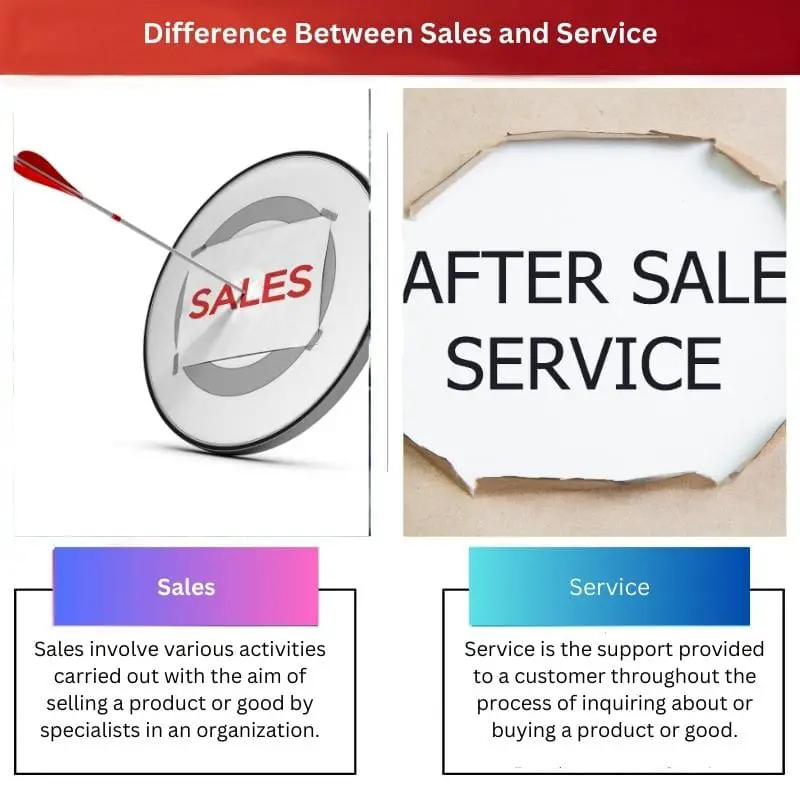Sales focuses on persuading customers to purchase products or services, emphasizing features and benefits to drive transactions. Service, on the other hand, prioritizes addressing customer needs post-purchase, ensuring satisfaction, resolving issues, and building long-term relationships to foster loyalty and retention.
Key Takeaways
- Sales involve selling a product or service to customers for a profit.
- Service involves providing customer assistance or support, after selling a product or service.
- While sales focus on generating revenue, service builds long-term customer relationships and enhances their overall experience.
Sales vs. Service
Sales involve identifying potential customers, understanding their needs and preferences, and convincing them that a particular product or service can meet their needs better than competitors. Service is provided to customers after a sale to ensure satisfaction and build long-term relationships.

Comparison Table
| Feature | Sales | Service |
|---|---|---|
| Primary Goal | Generate revenue by acquiring new customers and closing deals | Maintain customer satisfaction, resolve issues, and build long-term loyalty |
| Focus | New customers and revenue generation: Prospecting, building relationships, presenting solutions, negotiating deals | Existing customers and satisfaction: Addressing inquiries and complaints, troubleshooting problems, providing technical support |
| Metrics | Sales volume, conversion rate, revenue generated, quota attainment | Customer satisfaction score (CSAT), resolution rate, first-call resolution, average handle time |
| Skills & Qualities | Target-oriented, persuasive, relationship-building, negotiation | Patient, empathetic, problem-solving, communication, technical knowledge (depending on role) |
| Activities | Lead generation, qualification, presentations, proposal writing, negotiation | Issue resolution, troubleshooting, technical support, training, customer relationship management |
| Typical Interactions | Prospecting calls, sales meetings, negotiations | Phone calls, emails, live chat, in-person support |
| Relationship to Customer | Building initial relationships with new customers | Building and maintaining long-term relationships with existing customers |
| Impact on Business | Direct impact on revenue generation and growth | Indirect impact on revenue through customer retention and word-of-mouth marketing |
What is Sales?
Sales encompass the process of persuading potential customers to purchase products or services offered by a business entity. It involves the exchange of goods or services for monetary compensation, thereby generating revenue for the company. The sales function is crucial for organizations across various industries, as it directly impacts profitability and growth.
Components of Sales
- Prospecting and Lead Generation: This initial phase involves identifying and qualifying potential customers who may have an interest in the products or services being offered. It includes activities such as market research, lead generation, and building a database of prospects.
- Sales Presentations and Demonstrations: Once prospects have been identified, sales professionals engage in presentations and demonstrations to showcase the features and benefits of their offerings. This stage aims to educate potential customers about how the product or service can meet their needs and solve their problems.
- Negotiation and Closing: During this stage, sales representatives negotiate terms, address objections, and work towards closing the deal. Effective negotiation skills are crucial in reaching mutually beneficial agreements that satisfy both the customer and the company.
- Follow-up and Relationship Management: After the sale is made, the sales process continues with follow-up activities aimed at ensuring customer satisfaction and fostering long-term relationships. This may include providing ongoing support, addressing any post-purchase concerns, and seeking feedback to improve future interactions.
Importance of Sales
Sales serve as the lifeblood of any business, driving revenue generation and fueling growth opportunities. A robust sales strategy enables companies to expand their customer base, penetrate new markets, and outperform competitors. Additionally, effective sales practices contribute to enhancing brand reputation and fostering customer loyalty, leading to repeat business and referrals. Overall, sales play a pivotal role in achieving organizational objectives and sustaining long-term success.

What is Service?
Service refers to the provision of assistance, support, or solutions to customers before, during, and after the purchase of a product or service. It encompasses a wide range of activities aimed at enhancing customer satisfaction, resolving issues, and building long-term relationships. Service plays a crucial role in maintaining customer loyalty and driving repeat business.
Components of Service
- Pre-Sale Support and Assistance: Before a purchase is made, service may involve providing information, answering inquiries, and guiding customers through the decision-making process. This could include assistance with product selection, customization options, and addressing any concerns or questions the customer may have.
- Post-Sale Support and Maintenance: After the purchase is completed, service continues with activities such as installation, setup, and ongoing maintenance. This ensures that customers can effectively utilize the product or service they’ve acquired and helps address any issues or challenges that may arise during its use.
- Issue Resolution and Customer Support: Service also involves promptly addressing customer concerns, complaints, or technical issues. This may include troubleshooting problems, providing technical support, and offering solutions to ensure a positive customer experience. Effective issue resolution is essential for maintaining customer satisfaction and loyalty.
- Relationship Building and Customer Engagement: Beyond addressing immediate needs, service focuses on building strong, lasting relationships with customers. This involves proactive communication, personalized interactions, and efforts to understand and anticipate customer preferences and requirements. Building a strong rapport with customers fosters loyalty, encourages repeat business, and can lead to positive word-of-mouth referrals.
Importance of Service
Service is critical for businesses seeking to differentiate themselves in competitive markets and sustain long-term success. By providing exceptional service experiences, companies can enhance their reputation, increase customer loyalty, and drive repeat purchases. Moreover, satisfied customers are more likely to become brand advocates, promoting the company through positive reviews and referrals. Therefore, investing in service excellence is not only essential for meeting customer expectations but also for achieving business growth and profitability in the long run.

Main Differences Between Sales and Service
- Focus:
- Sales primarily focuses on persuading customers to make purchases and driving revenue generation.
- Service concentrates on addressing customer needs post-purchase, ensuring satisfaction, and fostering long-term relationships.
- Activities:
- Sales involves activities such as prospecting, lead generation, negotiation, and closing deals.
- Service encompasses activities like pre-sale assistance, post-sale support, issue resolution, and relationship building.
- Outcome:
- Sales aims to generate revenue by converting prospects into customers and completing transactions.
- Service aims to maintain customer satisfaction, loyalty, and retention, thus sustaining revenue streams and fostering business growth.






